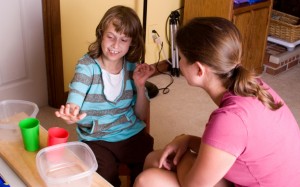Treatment for Children with Cerebral Palsy

Cerebral Palsy Treatment
There is no one standard treatment or therapy for cerebral palsy. Cerebral palsy affects each person differently, so treatment must be individually tailored as well.
Since there is no “cure” for cerebral palsy, most doctors focus on finding treatment and therapy geared toward managing or diminishing the neurological problems and physical limitations associated with cerebral palsy. Not only can help children learn to use their limbs as best as possible, it can also improve bone strength, flexibility, coordination, and help with posture.
The treatment options for cerebral palsy consist of numerous therapeutic and medical options, and not all treatments are painful or invasive. Most experts agree that a combination of treatments, given in conjunction with one another, produce the best results. A person’s healthcare team will work together to prescribe a balanced regimen of treatment designed to increase the child’s quality of life.
The Most Successful Treatments and Therapy for Cerebral Palsy
Remember that each treatment has its own risks and benefits. An individualized therapy and treatment regimen for cerebral palsy may include:
- Art Therapy – which seeks to improve self-confidence, pride, self-image, and can even improve speech patterns.
- Assistive Devices – such as leg braces, scooters, wheelchairs, and even utensils and writing devices.
- Aquatic Therapy – which allows those with mobility problems to exercise in water, which can provide for more-intense workouts.
- – which is a surgically implanted pump used to administer a drug used to reduce muscle spasticity.
- Behavioral Therapy – uses psychological theory and techniques to complement physical, speech or occupational therapy.
- Botox & Dysport Injections – which can reduce muscle tightness and decrease the likeliness of permanent muscle contracture.
- Caregivers – who can provide short and/or long term supplemental care for children with disabilities.
- Constraint-Induced Movement Therapy – which seeks to improve and restore the usability of a child’s arm or leg.
- Diet Planning, Foods & Nutrition – As changing the way you feed your child or prepare his or her food can make a big difference.
- Emotional Counseling – to assist in creating and maintaining a positive self-image and attitude.
- Hippotherapy / Horseback Riding Therapy – which can be therapeutic and helps strengthen muscles, improve balance and coordination.
- Hyperbaric Oxygen Therapy – to attempt to revive damaged brain cells in newborn children who suffered hypoxia or asphyxiation.
- Massage Therapy – to help release tension, improve blood flow, and improve a child’s range of movement.
- Medication & Drugs – to control muscle spasms and seizures, relieve pain, and reduce symptoms.
- Nutrition Therapy – to help with issues such as weight gain and malnutrition through dietary planning and meal plans.
- Occupational Therapy – designed to increase self-sufficiency in cerebral palsy patients.
- Orthopedic Surgery – to increase the patient’s range of motion, which may also involve surgery to correct spinal curves or prevent dislocation of the hip. Two common types of surgical procedures are Selective Dorsal Rhizotomy and SEMLARASS.
- Physical Therapy – using specific sets of exercises to work toward improving motor skills, as well as preventing weakening in muscles that can result from a lack of use.
- Sensory Integration Therapy – which seeks to alleviate any difficulties in registering, modulating, interpreting, and acting on information that comes to the brain through various sensory receptors.
- Serial Casting – which seeks to facilitate movement by stretching out muscle groups and tendons.
- Speech Therapy – to help increase or hone communication skills in children with cerebral palsy.
- Stem Cell Therapy / Umbilical Cord Blood – to stimulate neurogenesis by transplanting your child’s own stem cells into different areas of the body.
Vision, Hearing and Speech
Cerebral palsy causes problems controlling the muscles, which can mean that speech is sometimes affected. With a good speech therapist, however, they can oftentimes learn to speak quite. This is an important factor in helping to make people who suffer from CP feel less isolated.
Vision and hearing are oftentimes affected by this disorder as well. Corrective lenses and hearing aids are used to treat these symptoms. With proper corrective devices, people with CP can often hear as well as anyone else. Of course this helps with speech, as well!
Walking
Walking takes an enormous amount of muscle coordination, and those with cerebral palsy often experience diminished muscular control. That means that many sufferers have a very hard time walking (e.g., toe walking), if they can walk at all.
Various types of assistive devices—from crutches & wheelchairs to constraint therapy—can help with this. Children with cerebral palsy-related walking difficulties can also benefit from physical therapy, which can increase their ability to control their muscles and to maintain their balance.
